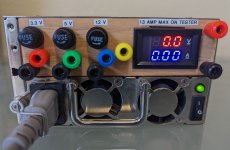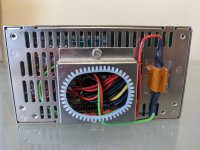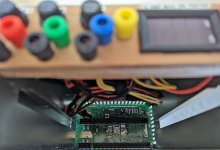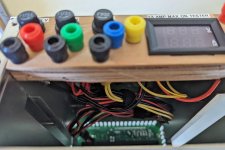I'd been getting into electronics tinkering (especially on ESP32 devices via ESPHome), and needed a good benchtop power supply. Fortunately, I also had an old server that was bound for the recycling center, which had fancy redundant power supply. While I'd seen projects that used old PSUs like this before, they usually run the cables outside of the case (meaning they weren't self-contained or clean). With this, I figured I'd be able to remove one of the redundant power supplies and keep everything internal.

Preparation
After removing the front of the power supply, I identified the cables that I would need to keep:
Everything that wasn't identified as needed got cut off. This power supply also had a very loud alarm that would sound when one power supply failed, which required a button press to silence. Since I would only ever be using one power supply in it, that meant that I had to press the silence button every time I used it. I believe that the button was connected to the main power supply board via 2 pins, which I was able to use a standard computer jumper on. I may have placed a blob of solder across it instead; I don't remember now. Either way, I simply shorted that button out to silence that alarm.
With that done, I routed the rest of the cables. The PSU's motherboard fortunately had a hole in it that was small enough to route all of my connection cables through. I also needed to place a dummy load between +5v and ground to keep the PSU on, and connect PS-ON to ground to switch the PSU from standby to on. In other projects, I have seen the PSO > ground connection go through a switch, but since the PSU had a switch of its own, I just needed to connect it to ground. After some experimentation, I found that I could tie it to the same ground wire as my dummy load. Similarly, I often see these use power LEDs, but I had an LED next to the built-in switch. Unfortunately, there wasn't room inside the PSU for the dummy load resistor, so I ran it outside of the case and mounted it to the front panel. I found that the resistor gets pretty hot by itself, but simply screwing it to the metal case was enough to keep it cool.

The front of the PSU. That hole would usually have a host of wires coming from it, but most of them have been cut off now.

Inside the PSU, with the power supply itself removed. You can see where the two PSUs would normally connect, and the hole that I was able to route the bulk of my wires through.
As you may have noticed, I brought forward each voltage (3.3v, 5v, and 12v), with 2 positive wires and 2 ground wires for each. That is because I wanted to be able to carry more current from the PSU to the test device. I ran each pair of positive wires to a fuse holder, ran 2 wires to the relevant banana jack, and then ran 2 ground wires to each ground banana jack. I also connected up banana jacks going from the power tester--there's an input positive voltage, an output positive voltage, and a ground. Since the wires built into the tester were thinner (i.e., I couldn't add more wires to carry more current), I only ran one ground wire to the tester's post.
The Faceplate
I would have liked to have used sheet metal to build the faceplate, but I had wood on hand. It turns out to have worked quite well. I measured each component that was going through the front, laid out some designs in Illustrator that would allow all of them to fit, and then drilled the appropriate holes with my drill press.

As you can see, getting everything to fit was a challenge--the through-holes were fine, but the actual cases and solder joints for the components was quite large.
I then pulled the cables that I'd routed through the motherboard up, soldered them in place through the wood (with much testing, re-alignment, hole-expanding, and cussing), and mounted everything. I bundled the cables so that they would stay up out of the way if I slid the PSU in/out of the case, and used some existing screw holes in the case to mount the faceplate.

This is as much of my existing solder joints and drilling work as I'm going to show you--it's not pretty back there.
End Result
This has turned out to be a fantastic tool for my shop. I haven't tested it with any high-powered projects, but it should be able to provide up to 26 amps for each voltage (up to 312 watts @ 12v, or nearly 530 watts if I'm maxing out all three voltages at once). One of the unexpectedly great benefits of using this particular power supply is that the PSUs have a handle on them, which was originally intended to slide them out for replacement without removing the server. However, it's sturdy enough that I can easily carry around the entire power supply with it.
Changes/Improvements
If I was going to take this apart or do it again, I'd probably make a couple of changes:

Preparation
After removing the front of the power supply, I identified the cables that I would need to keep:
- 2x +12v (yellow wires)
- 3x +5v (red wires)
- 2x +3.3v (orange wires)
- 8x ground (black wires)
- PS-ON wire (green wire)
- A 10-watt resistor for a dummy load
- An inline power meter. This isn't required, but is nice to have.
- Some banana plug-style binding posts.
- Fuses and fuse holders.
- Some bits of wire were used inside the PSU, and some alligator clips and banana plugs were used to make the leads, but these ingredients were all pulled from my parts bin.
Everything that wasn't identified as needed got cut off. This power supply also had a very loud alarm that would sound when one power supply failed, which required a button press to silence. Since I would only ever be using one power supply in it, that meant that I had to press the silence button every time I used it. I believe that the button was connected to the main power supply board via 2 pins, which I was able to use a standard computer jumper on. I may have placed a blob of solder across it instead; I don't remember now. Either way, I simply shorted that button out to silence that alarm.
With that done, I routed the rest of the cables. The PSU's motherboard fortunately had a hole in it that was small enough to route all of my connection cables through. I also needed to place a dummy load between +5v and ground to keep the PSU on, and connect PS-ON to ground to switch the PSU from standby to on. In other projects, I have seen the PSO > ground connection go through a switch, but since the PSU had a switch of its own, I just needed to connect it to ground. After some experimentation, I found that I could tie it to the same ground wire as my dummy load. Similarly, I often see these use power LEDs, but I had an LED next to the built-in switch. Unfortunately, there wasn't room inside the PSU for the dummy load resistor, so I ran it outside of the case and mounted it to the front panel. I found that the resistor gets pretty hot by itself, but simply screwing it to the metal case was enough to keep it cool.

The front of the PSU. That hole would usually have a host of wires coming from it, but most of them have been cut off now.

Inside the PSU, with the power supply itself removed. You can see where the two PSUs would normally connect, and the hole that I was able to route the bulk of my wires through.
As you may have noticed, I brought forward each voltage (3.3v, 5v, and 12v), with 2 positive wires and 2 ground wires for each. That is because I wanted to be able to carry more current from the PSU to the test device. I ran each pair of positive wires to a fuse holder, ran 2 wires to the relevant banana jack, and then ran 2 ground wires to each ground banana jack. I also connected up banana jacks going from the power tester--there's an input positive voltage, an output positive voltage, and a ground. Since the wires built into the tester were thinner (i.e., I couldn't add more wires to carry more current), I only ran one ground wire to the tester's post.
The Faceplate
I would have liked to have used sheet metal to build the faceplate, but I had wood on hand. It turns out to have worked quite well. I measured each component that was going through the front, laid out some designs in Illustrator that would allow all of them to fit, and then drilled the appropriate holes with my drill press.

As you can see, getting everything to fit was a challenge--the through-holes were fine, but the actual cases and solder joints for the components was quite large.
I then pulled the cables that I'd routed through the motherboard up, soldered them in place through the wood (with much testing, re-alignment, hole-expanding, and cussing), and mounted everything. I bundled the cables so that they would stay up out of the way if I slid the PSU in/out of the case, and used some existing screw holes in the case to mount the faceplate.

This is as much of my existing solder joints and drilling work as I'm going to show you--it's not pretty back there.
End Result
This has turned out to be a fantastic tool for my shop. I haven't tested it with any high-powered projects, but it should be able to provide up to 26 amps for each voltage (up to 312 watts @ 12v, or nearly 530 watts if I'm maxing out all three voltages at once). One of the unexpectedly great benefits of using this particular power supply is that the PSUs have a handle on them, which was originally intended to slide them out for replacement without removing the server. However, it's sturdy enough that I can easily carry around the entire power supply with it.
Changes/Improvements
If I was going to take this apart or do it again, I'd probably make a couple of changes:
- I'd make the faceplate out of a better material. Sheet metal would be ideal, but at least thinner wood of a higher quality (I just used whatever plywood I had laying around) would make building the faceplate significantly easier, as well as making it look nicer.
- I'd rework the soldering behind the faceplate--it was really hard to solder around the thicker wood
- I'd cover the unused power wires that I cut. While they're cut far enough apart that there shouldn't be any shorts, and I don't think anyone's going to stick their finger in through the hole in the front while it's running, and it's not mains power, I don't love having exposed live wires of any voltage. I would think a bit of work with a hot glue gun would be enough.
